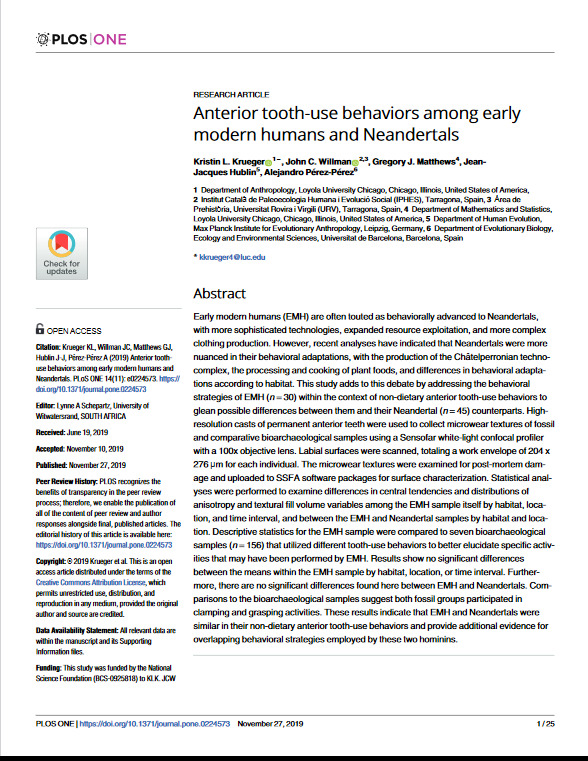Anterior Tooth-Use Behaviors Among Early Modern Humans and Neandertals
Item
Title
Anterior Tooth-Use Behaviors Among Early Modern Humans and Neandertals
Loyola Faculty Contributor
Kristin Krueger
Link
List of Authors
Kristin L. Krueger; John C. Willman; Gregory J. Matthews; Jean-Jacques Hublin; Alejandro Pérez-Pérez
Abstract
Early modern humans (EMH) are often touted as behaviorally advanced to Neandertals, with more sophisticated technologies, expanded resource exploitation, and more complex clothing production. However, recent analyses have indicated that Neandertals were more nuanced in their behavioral adaptations, with the production of the Châtelperronian technocomplex, the processing and cooking of plant foods, and differences in behavioral adaptations according to habitat. This study adds to this debate by addressing the behavioral strategies of EMH (n = 30) within the context of non-dietary anterior tooth-use behaviors to glean possible differences between them and their Neandertal (n = 45) counterparts. High-resolution casts of permanent anterior teeth were used to collect microwear textures of fossil and comparative bioarchaeological samples using a Sensofar white-light confocal profiler with a 100x objective lens. Labial surfaces were scanned, totaling a work envelope of 204 x 276 μm for each individual. The microwear textures were examined for post-mortem damage and uploaded to SSFA software packages for surface characterization. Statistical analyses were performed to examine differences in central tendencies and distributions of anisotropy and textural fill volume variables among the EMH sample itself by habitat, location, and time interval, and between the EMH and Neandertal samples by habitat and location. Descriptive statistics for the EMH sample were compared to seven bioarchaeological samples (n = 156) that utilized different tooth-use behaviors to better elucidate specific activities that may have been performed by EMH. Results show no significant differences between the means within the EMH sample by habitat, location, or time interval. Furthermore, there are no significant differences found here between EMH and Neandertals. Comparisons to the bioarchaeological samples suggest both fossil groups participated in clamping and grasping activities. These results indicate that EMH and Neandertals were similar in their non-dietary anterior tooth-use behaviors and provide additional evidence for overlapping behavioral strategies employed by these two hominins.
Date
27-Nov-19
Publication Title
PLoSONE
Publisher
PLOS
Identifier
10.1371/journal.pone.0224573
Bibliographic Citation
Krueger KL, Willman JC, Matthews GJ, Hublin J-J, Pérez-Pérez A (2019) Anterior tooth-use behaviors among early modern humans and Neandertals. PLoS ONE 14(11): e0224573. https://doi.org/10.1371/journal.pone.0224573

